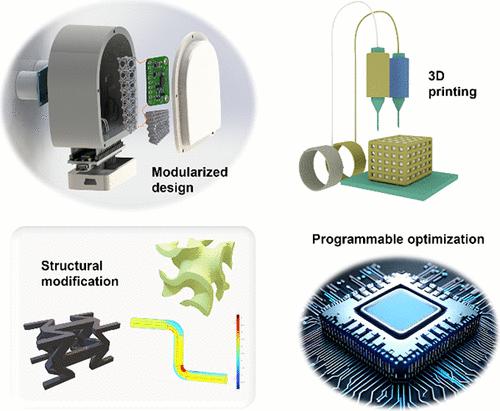当前位置:
X-MOL 学术
›
Chem. Rev.
›
论文详情
Our official English website, www.x-mol.net, welcomes your feedback! (Note: you will need to create a separate account there.)
Programmable and Modularized Gas Sensor Integrated by 3D Printing
Chemical Reviews ( IF 62.1 ) Pub Date : 2024-03-18 , DOI: 10.1021/acs.chemrev.3c00853 Shixiang Zhou 1 , Yijing Zhao 2 , Yanran Xun 1 , Zhicheng Wei 1 , Yong Yang 3 , Wentao Yan 2 , Jun Ding 1
Chemical Reviews ( IF 62.1 ) Pub Date : 2024-03-18 , DOI: 10.1021/acs.chemrev.3c00853 Shixiang Zhou 1 , Yijing Zhao 2 , Yanran Xun 1 , Zhicheng Wei 1 , Yong Yang 3 , Wentao Yan 2 , Jun Ding 1
Affiliation

|
The rapid advancement of intelligent manufacturing technology has enabled electronic equipment to achieve synergistic design and programmable optimization through computer-aided engineering. Three-dimensional (3D) printing, with the unique characteristics of near-net-shape forming and mold-free fabrication, serves as an effective medium for the materialization of digital designs into usable devices. This methodology is particularly applicable to gas sensors, where performance can be collaboratively optimized by the tailored design of each internal module including composition, microstructure, and architecture. Meanwhile, diverse 3D printing technologies can realize modularized fabrication according to the application requirements. The integration of artificial intelligence software systems further facilitates the output of precise and dependable signals. Simultaneously, the self-learning capabilities of the system also promote programmable optimization for the hardware, fostering continuous improvement of gas sensors for dynamic environments. This review investigates the latest studies on 3D-printed gas sensor devices and relevant components, elucidating the technical features and advantages of different 3D printing processes. A general testing framework for the performance evaluation of customized gas sensors is proposed. Additionally, it highlights the superiority and challenges of programmable and modularized gas sensors, providing a comprehensive reference for material adjustments, structure design, and process modifications for advanced gas sensor devices.
中文翻译:

通过 3D 打印集成的可编程模块化气体传感器
智能制造技术的快速进步,使得电子设备能够通过计算机辅助工程实现协同设计和可编程优化。三维 (3D) 打印具有近净成形成型和无模具制造的独特特性,可作为将数字设计具体化为可用设备的有效媒介。这种方法特别适用于气体传感器,可以通过每个内部模块(包括成分、微观结构和架构)的定制设计来协同优化性能。同时,多种3D打印技术可以根据应用需求实现模块化制造。人工智能软件系统的集成进一步促进了精确可靠信号的输出。同时,系统的自学习能力也促进了硬件的可编程优化,促进了动态环境下气体传感器的不断改进。本文综述了3D打印气体传感器器件和相关组件的最新研究,阐明了不同3D打印工艺的技术特点和优势。提出了定制气体传感器性能评估的通用测试框架。此外,它还突出了可编程和模块化气体传感器的优越性和挑战,为先进气体传感器器件的材料调整、结构设计和工艺修改提供了全面的参考。
更新日期:2024-03-18
中文翻译:

通过 3D 打印集成的可编程模块化气体传感器
智能制造技术的快速进步,使得电子设备能够通过计算机辅助工程实现协同设计和可编程优化。三维 (3D) 打印具有近净成形成型和无模具制造的独特特性,可作为将数字设计具体化为可用设备的有效媒介。这种方法特别适用于气体传感器,可以通过每个内部模块(包括成分、微观结构和架构)的定制设计来协同优化性能。同时,多种3D打印技术可以根据应用需求实现模块化制造。人工智能软件系统的集成进一步促进了精确可靠信号的输出。同时,系统的自学习能力也促进了硬件的可编程优化,促进了动态环境下气体传感器的不断改进。本文综述了3D打印气体传感器器件和相关组件的最新研究,阐明了不同3D打印工艺的技术特点和优势。提出了定制气体传感器性能评估的通用测试框架。此外,它还突出了可编程和模块化气体传感器的优越性和挑战,为先进气体传感器器件的材料调整、结构设计和工艺修改提供了全面的参考。



























 京公网安备 11010802027423号
京公网安备 11010802027423号